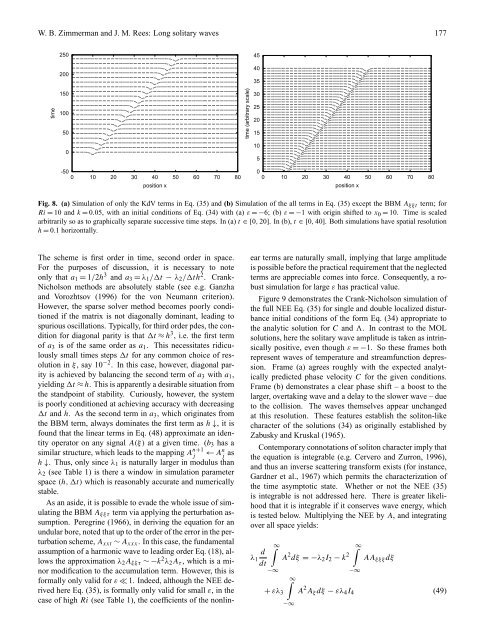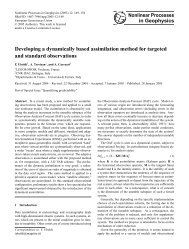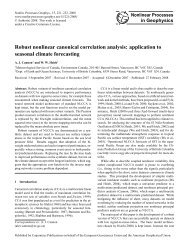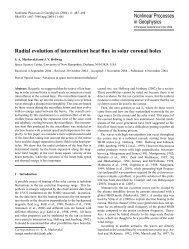Long solitary internal waves in stable stratifications
Long solitary internal waves in stable stratifications
Long solitary internal waves in stable stratifications
You also want an ePaper? Increase the reach of your titles
YUMPU automatically turns print PDFs into web optimized ePapers that Google loves.
W. B. Zimmerman and J. M. Rees: <strong>Long</strong> <strong>solitary</strong> <strong>waves</strong> 177<br />
time<br />
250<br />
200<br />
150<br />
100<br />
50<br />
0<br />
-50<br />
0 10 20 30 40 50 60 70 80<br />
position x<br />
time (arbitrary scale)<br />
45<br />
40<br />
35<br />
30<br />
25<br />
20<br />
15<br />
10<br />
5<br />
0<br />
0 10 20 30 40 50 60 70 80<br />
position x<br />
Fig. 8. (a) Simulation of only the KdV terms <strong>in</strong> Eq. (35) and (b) Simulation of the all terms <strong>in</strong> Eq. (35) except the BBM A ξξt term; for<br />
Ri = 10 and k = 0.05, with an <strong>in</strong>itial conditions of Eq. (34) with (a) ε = −6; (b) ε = −1 with orig<strong>in</strong> shifted to x 0 = 10. Time is scaled<br />
arbitrarily so as to graphically separate successive time steps. In (a) t ∈ [0, 20]. In (b), t ∈ [0, 40]. Both simulations have spatial resolution<br />
h = 0.1 horizontally.<br />
The scheme is first order <strong>in</strong> time, second order <strong>in</strong> space.<br />
For the purposes of discussion, it is necessary to note<br />
only that a 1 = 1/2h 3 and a 3 = λ 1 /t − λ 2 /th 2 . Crank-<br />
Nicholson methods are absolutely <strong>stable</strong> (see e.g. Ganzha<br />
and Vorozhtsov (1996) for the von Neumann criterion).<br />
However, the sparse solver method becomes poorly conditioned<br />
if the matrix is not diagonally dom<strong>in</strong>ant, lead<strong>in</strong>g to<br />
spurious oscillations. Typically, for third order pdes, the condition<br />
for diagonal parity is that t ≈ h 3 , i.e. the first term<br />
of a 3 is of the same order as a 1 . This necessitates ridiculously<br />
small times steps t for any common choice of resolution<br />
<strong>in</strong> ξ, say 10 −2 . In this case, however, diagonal parity<br />
is achieved by balanc<strong>in</strong>g the second term of a 3 with a 1 ,<br />
yield<strong>in</strong>g t ≈ h. This is apparently a desirable situation from<br />
the standpo<strong>in</strong>t of stability. Curiously, however, the system<br />
is poorly conditioned at achiev<strong>in</strong>g accuracy with decreas<strong>in</strong>g<br />
t and h. As the second term <strong>in</strong> a 3 , which orig<strong>in</strong>ates from<br />
the BBM term, always dom<strong>in</strong>ates the first term as h ↓, it is<br />
found that the l<strong>in</strong>ear terms <strong>in</strong> Eq. (48) approximate an identity<br />
operator on any signal A(ξ) at a given time. (b 3 has a<br />
similar structure, which leads to the mapp<strong>in</strong>g A n+1<br />
j<br />
← A n j as<br />
h ↓. Thus, only s<strong>in</strong>ce λ 1 is naturally larger <strong>in</strong> modulus than<br />
λ 2 (see Table 1) is there a w<strong>in</strong>dow <strong>in</strong> simulation parameter<br />
space (h, t) which is reasonably accurate and numerically<br />
<strong>stable</strong>.<br />
As an aside, it is possible to evade the whole issue of simulat<strong>in</strong>g<br />
the BBM A ξξτ term via apply<strong>in</strong>g the perturbation assumption.<br />
Peregr<strong>in</strong>e (1966), <strong>in</strong> deriv<strong>in</strong>g the equation for an<br />
undular bore, noted that up to the order of the error <strong>in</strong> the perturbation<br />
scheme, A xxt ∼ A xxx . In this case, the fundamental<br />
assumption of a harmonic wave to lead<strong>in</strong>g order Eq. (18), allows<br />
the approximation λ 2 A ξξτ ∼ −k 2 λ 2 A τ , which is a m<strong>in</strong>or<br />
modification to the accumulation term. However, this is<br />
formally only valid for ε ≪ 1. Indeed, although the NEE derived<br />
here Eq. (35), is formally only valid for small ε, <strong>in</strong> the<br />
case of high Ri (see Table 1), the coefficients of the nonl<strong>in</strong>ear<br />
terms are naturally small, imply<strong>in</strong>g that large amplitude<br />
is possible before the practical requirement that the neglected<br />
terms are appreciable comes <strong>in</strong>to force. Consequently, a robust<br />
simulation for large ε has practical value.<br />
Figure 9 demonstrates the Crank-Nicholson simulation of<br />
the full NEE Eq. (35) for s<strong>in</strong>gle and double localized disturbance<br />
<strong>in</strong>itial conditions of the form Eq. (34) appropriate to<br />
the analytic solution for C and . In contrast to the MOL<br />
solutions, here the <strong>solitary</strong> wave amplitude is taken as <strong>in</strong>tr<strong>in</strong>sically<br />
positive, even though ε = −1. So these frames both<br />
represent <strong>waves</strong> of temperature and streamfunction depression.<br />
Frame (a) agrees roughly with the expected analytically<br />
predicted phase velocity C for the given conditions.<br />
Frame (b) demonstrates a clear phase shift – a boost to the<br />
larger, overtak<strong>in</strong>g wave and a delay to the slower wave – due<br />
to the collision. The <strong>waves</strong> themselves appear unchanged<br />
at this resolution. These features establish the soliton-like<br />
character of the solutions (34) as orig<strong>in</strong>ally established by<br />
Zabusky and Kruskal (1965).<br />
Contemporary connotations of soliton character imply that<br />
the equation is <strong>in</strong>tegrable (e.g. Cervero and Zurron, 1996),<br />
and thus an <strong>in</strong>verse scatter<strong>in</strong>g transform exists (for <strong>in</strong>stance,<br />
Gardner et al., 1967) which permits the characterization of<br />
the time asymptotic state. Whether or not the NEE (35)<br />
is <strong>in</strong>tegrable is not addressed here. There is greater likelihood<br />
that it is <strong>in</strong>tegrable if it conserves wave energy, which<br />
is tested below. Multiply<strong>in</strong>g the NEE by A, and <strong>in</strong>tegrat<strong>in</strong>g<br />
over all space yields:<br />
d<br />
λ 1<br />
dt<br />
∫ ∞<br />
−∞<br />
A 2 dξ = −λ 2 I 2 − k 2<br />
∫∞<br />
−∞<br />
AA ξξξ dξ<br />
∫∞<br />
+ ελ 3 A 2 A ξ dξ − ελ 4 I 4 (49)<br />
−∞






